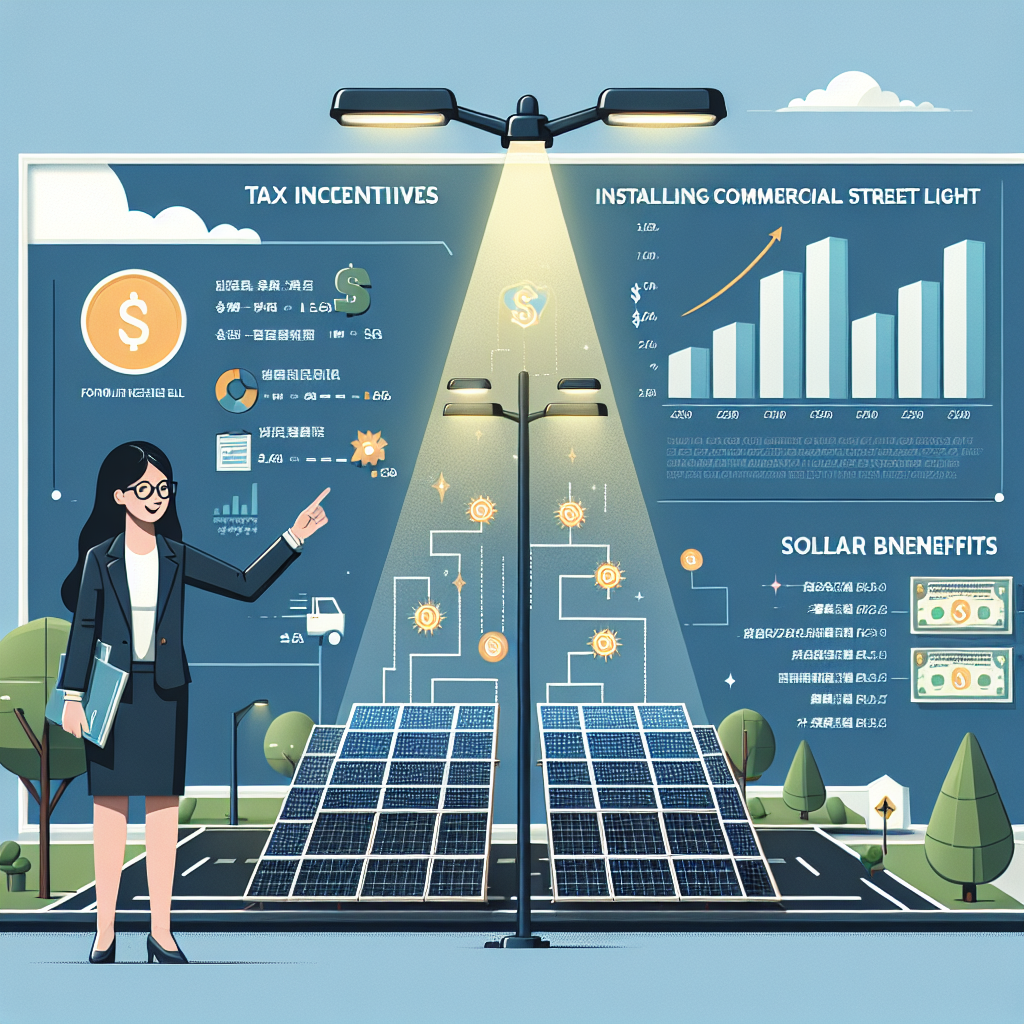Tax Incentives for Installing Commercial Solar Street Lights
Table of Contents
Tax incentives for installing commercial solar street lights are financial benefits provided by governments to encourage businesses and municipalities to adopt renewable energy solutions. These incentives can take various forms, including tax credits, deductions, rebates, and grants, aimed at reducing the initial investment costs associated with solar technology. By implementing solar street lighting, organizations can not only decrease their carbon footprint and energy expenses but also contribute to broader environmental sustainability goals. Tax incentives play a crucial role in making these projects more financially viable, accelerating the transition to clean energy infrastructure, and fostering innovation in the renewable energy sector.
Benefits Of Tax Incentives For Commercial Solar Street Light Installations
The implementation of tax incentives for installing commercial solar street lights presents a compelling opportunity for businesses and municipalities to embrace sustainable energy solutions while simultaneously reaping financial benefits. As the world increasingly shifts towards renewable energy sources, governments are recognizing the importance of encouraging such transitions through fiscal policies. Tax incentives serve as a powerful tool in this regard, offering a range of advantages that extend beyond mere cost savings.
To begin with, tax incentives significantly reduce the initial financial burden associated with the installation of solar street lights. The upfront costs of purchasing and installing solar technology can be substantial, often deterring potential adopters. However, with tax credits or deductions, businesses can offset a portion of these expenses, making the investment more financially viable. This reduction in initial costs not only encourages more widespread adoption but also accelerates the transition to cleaner energy sources.
Moreover, tax incentives for solar street lights contribute to long-term financial savings. Once installed, solar street lights harness energy from the sun, which is both abundant and free. This leads to a substantial decrease in electricity bills, as reliance on traditional power sources diminishes. Over time, the savings on energy costs can be significant, allowing businesses and municipalities to allocate resources to other critical areas. In this way, tax incentives not only facilitate the initial investment but also enhance the financial sustainability of the project in the long run.
In addition to financial benefits, tax incentives for solar street lights play a crucial role in promoting environmental sustainability. By reducing dependence on fossil fuels, solar street lights contribute to a decrease in greenhouse gas emissions, thereby mitigating the impact of climate change. Governments, by offering tax incentives, signal their commitment to environmental stewardship and encourage businesses to align with these values. This alignment not only enhances the reputation of businesses as environmentally responsible entities but also fosters a culture of sustainability within communities.
Furthermore, the adoption of solar street lights, spurred by tax incentives, can stimulate economic growth. The increased demand for solar technology can lead to job creation in the renewable energy sector, ranging from manufacturing and installation to maintenance and research. This growth in employment opportunities can have a positive ripple effect on local economies, contributing to overall economic development. Tax incentives, therefore, not only benefit individual businesses but also have broader socio-economic implications.
Additionally, the implementation of solar street lights can enhance public safety and community well-being. Well-lit streets deter criminal activities and reduce accidents, creating safer environments for residents and businesses alike. By incentivizing the installation of solar street lights, governments can indirectly contribute to improved public safety, which is a fundamental aspect of community development.
In conclusion, tax incentives for installing commercial solar street lights offer a multifaceted array of benefits that extend beyond mere financial savings. They reduce initial investment costs, promote long-term economic sustainability, and contribute to environmental conservation. Moreover, they stimulate economic growth and enhance public safety, underscoring their value as a strategic policy tool. As the global community continues to prioritize sustainable development, such incentives will play an increasingly vital role in facilitating the transition to renewable energy solutions, ultimately benefiting businesses, communities, and the environment alike.
Navigating Tax Credits And Deductions For Solar Street Lighting Projects

Navigating the complex landscape of tax incentives for installing commercial solar street lights can be a daunting task for businesses and municipalities alike. However, understanding these financial benefits is crucial for making informed decisions that not only enhance public infrastructure but also promote environmental sustainability. As governments worldwide increasingly prioritize renewable energy, various tax credits and deductions have been introduced to encourage the adoption of solar technologies, including solar street lighting projects.
To begin with, one of the most significant incentives available is the federal Investment Tax Credit (ITC), which allows businesses to deduct a substantial percentage of the cost of installing solar energy systems from their federal taxes. As of the current tax year, the ITC offers a 26% credit for solar systems on commercial properties, though this percentage is scheduled to decrease in the coming years unless further legislative action is taken. This credit can significantly reduce the upfront costs associated with solar street lighting projects, making them more financially viable for businesses and local governments.
In addition to the ITC, businesses may also benefit from accelerated depreciation through the Modified Accelerated Cost Recovery System (MACRS). This system allows for the depreciation of solar energy equipment over a five-year period, providing an additional tax benefit by reducing taxable income. The combination of the ITC and MACRS can lead to substantial savings, effectively lowering the overall cost of solar street lighting installations.
Moreover, state and local governments often offer their own incentives, which can vary widely depending on the region. These may include additional tax credits, rebates, or grants specifically designed to support renewable energy projects. For instance, some states provide performance-based incentives that reward businesses based on the amount of solar energy generated, further enhancing the financial attractiveness of solar street lighting.
Furthermore, it is essential to consider the potential for net metering, a policy that allows businesses to sell excess solar energy back to the grid. While net metering policies differ by state, they can provide an additional revenue stream for projects that generate more energy than they consume. This not only offsets energy costs but also contributes to a quicker return on investment.
Transitioning to solar street lighting also aligns with broader corporate social responsibility goals, as it demonstrates a commitment to sustainability and environmental stewardship. By reducing reliance on fossil fuels and lowering carbon emissions, businesses can enhance their public image and appeal to environmentally conscious consumers and stakeholders.
However, navigating these tax incentives requires careful planning and consultation with tax professionals or financial advisors who specialize in renewable energy projects. They can provide valuable insights into the eligibility criteria, application processes, and potential pitfalls associated with these incentives. Additionally, staying informed about legislative changes is crucial, as tax policies related to renewable energy are subject to change based on political and economic factors.
In conclusion, while the financial landscape of tax incentives for commercial solar street lighting projects may seem complex, the potential benefits are substantial. By leveraging federal, state, and local incentives, businesses and municipalities can significantly reduce the costs associated with these projects, making them a more attractive and sustainable option. As the world continues to shift towards renewable energy, understanding and utilizing these tax incentives will be key to successful solar street lighting installations.
Maximizing Financial Savings Through Solar Street Light Tax Incentives
In recent years, the global push towards sustainable energy solutions has gained significant momentum, with solar energy emerging as a leading contender in the quest for renewable power sources. Among the various applications of solar technology, commercial solar street lights have garnered attention for their potential to reduce energy costs and carbon footprints. As businesses and municipalities increasingly consider the transition to solar street lighting, understanding the financial incentives available can be crucial in maximizing savings. Tax incentives, in particular, play a pivotal role in offsetting the initial investment costs associated with installing solar street lights, thereby making the transition more economically viable.
To begin with, tax incentives for solar street lights are designed to encourage the adoption of renewable energy technologies by reducing the financial burden on businesses and local governments. These incentives often come in the form of tax credits, deductions, and rebates, which can significantly lower the overall cost of installation. For instance, the federal Investment Tax Credit (ITC) in the United States allows businesses to deduct a substantial percentage of the cost of installing solar energy systems from their federal taxes. This credit not only applies to solar panels but also extends to solar street lighting systems, thereby providing a direct financial benefit to those who choose to invest in this technology.
Moreover, many states and local governments offer additional incentives that complement federal programs. These may include property tax exemptions, sales tax exemptions, and performance-based incentives, which further enhance the financial attractiveness of solar street lights. By taking advantage of these state-specific programs, businesses can achieve even greater savings, thereby accelerating the return on investment. It is essential for businesses to conduct thorough research and consult with tax professionals to fully understand the range of incentives available in their region, as these can vary significantly from one jurisdiction to another.
In addition to direct financial incentives, the long-term cost savings associated with solar street lights should not be overlooked. Traditional street lighting systems rely on grid electricity, which can be subject to fluctuating energy prices and increasing utility costs. In contrast, solar street lights harness energy from the sun, providing a free and inexhaustible power source. Over time, the reduction in energy bills can lead to substantial savings, further justifying the initial investment. Furthermore, solar street lights typically require less maintenance than conventional lighting systems, as they have fewer moving parts and are designed to withstand harsh weather conditions. This translates to lower maintenance costs and reduced operational disruptions, contributing to overall financial efficiency.
While the financial benefits of tax incentives and long-term savings are compelling, it is also important to consider the broader environmental and social impacts of adopting solar street lights. By reducing reliance on fossil fuels, businesses and municipalities can significantly decrease their carbon emissions, contributing to a cleaner and more sustainable environment. Additionally, solar street lights can enhance public safety by providing reliable and consistent lighting, particularly in areas prone to power outages or lacking access to the electrical grid.
In conclusion, the decision to install commercial solar street lights is not only a step towards environmental responsibility but also a financially sound investment. By leveraging available tax incentives and understanding the long-term cost benefits, businesses and municipalities can maximize their financial savings while contributing to a sustainable future. As the world continues to embrace renewable energy solutions, the role of tax incentives in facilitating this transition cannot be overstated, making them an essential consideration for any entity contemplating the adoption of solar street lighting technology.
Read more about Solar Street Lighting:









